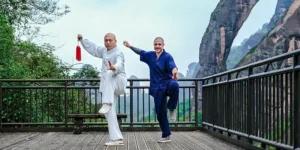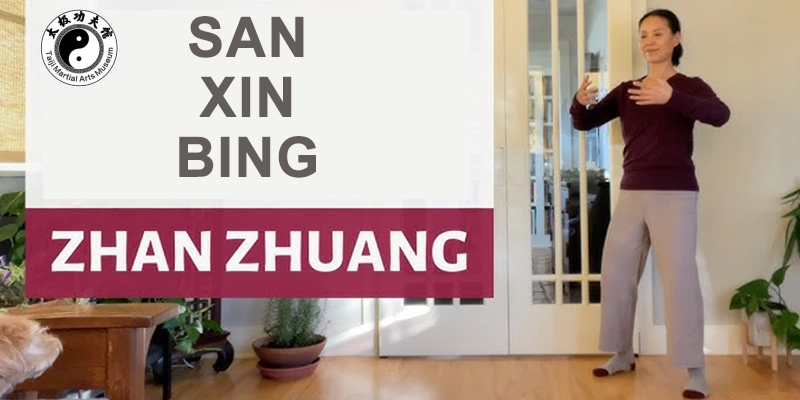
What is San Xin Bìng Zhan Zhuang?
At its heart, Zhàn Zhuāng, meaning “standing like a post” or “standing stake,” is a foundational practice within Qigong and internal martial arts like Tai Chi. It involves holding specific, seemingly simple standing postures for extended periods. San Xin Bìng Zhàn Zhuāng, often considered a fundamental or “first posture” (Zhàn Zhuāng 1st posture), translates roughly to “Three Hearts Merging Standing Post.” It focuses on aligning and harmonizing three key energy centers (“hearts” or “minds”) in the body: the head, chest, and lower abdomen. This practice is a core element of Zhan Zhuang Qigong and Tai Chi Zhan Zhuang, serving as a profound form of standing meditation.
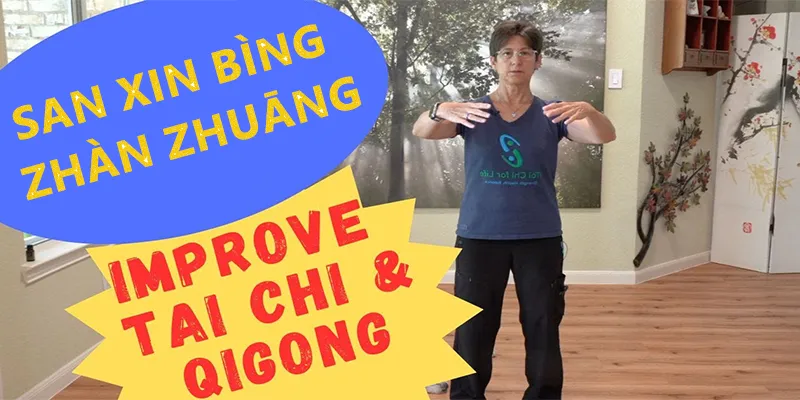
San Xin Bìng Zhan Zhuang Benefits
The benefits of Zhàn Zhuāng, especially San Xin Bìng Zhan Zhuang, stem from its unique blend of stillness and subtle internal activity:
- Deep Relaxation and Stress Reduction: Holding the posture requires releasing your tension. This activates the parasympathetic nervous system, significantly lowering stress hormones and inducing profound calm. This is a cornerstone benefit experienced inside Zhan Zhuang practice.
- Enhanced Posture, Alignment, and Balance: Maintaining the correct structure gently strengthens the deep postural muscles, improves spinal alignment, and dramatically enhances overall balance and stability.
- Improved Circulation and Energy Flow: The slight isometric tension in the legs acts like a pump, improving blood circulation throughout the body. Simultaneously, the focus on alignment and relaxation facilitates the smoother flow of Qi, vital for health and vitality.
- Increased Rooting and Groundedness: The practice cultivates a powerful sense of connection to the earth, fostering feelings of stability, presence, and inner strength that extend beyond the practice session.
- Mental Clarity and Focus: The meditative aspect of San Xin Bìng Zhan Zhuang quiets the mind, improves concentration, and enhances mindfulness—training attention through sustained awareness of posture, breath, and sensations.
- Strengthened Legs, Core, and Connective Tissues: While static, the posture deeply engages the legs, feet, and core muscles, along with tendons and ligaments, building foundational strength and resilience without high impact.
San Xin Bìng Zhan Zhuang and Health
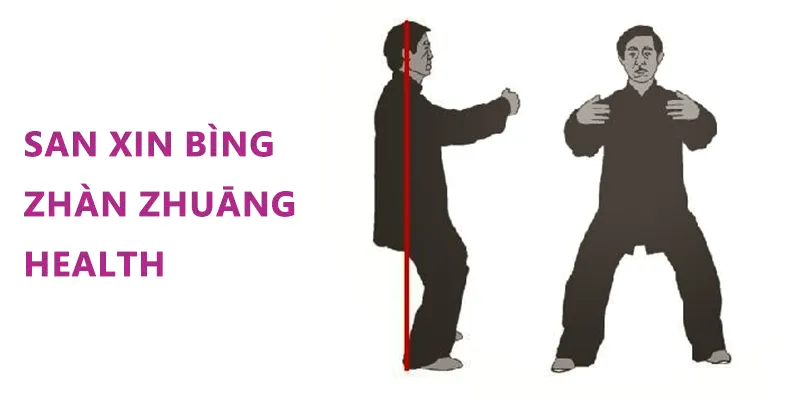
Many practitioners explore zhan zhuang for managing specific conditions. Research and evidence suggest potential benefits, though it should complement, not replace.
Can Zhan Zhuang help with essential tremors? The deep relaxation, improved neuromuscular control, and potential calming effect on the nervous system offered by San Xin Bìng Zhan Zhuang may help reduce the severity or frequency of essential tremors for some people.
Zhàn Zhuāng for Neuropathy: Improved circulation (Zhan Zhuang neuropathy / Zhan Zhuang nuropothy) is a primary benefit. Enhanced blood flow can potentially nourish nerves and alleviate symptoms like numbness, tingling, and pain in the hands and feet. The practice also promotes overall nervous system regulation.
Is Zhan Zhuang Enough Exercise?
Is Zhàn Zhuāng enough exercise? It depends on your fitness goals. As a standalone practice, it excels at building specific types of strength, balance, flexibility, and profound mental/energetic benefits.

However, it typically doesn’t provide significant cardiovascular exercise or high-calorie burn. For comprehensive fitness, it’s best combined with aerobic activities like walking and swimming and potentially dynamic practices like Tai Chi forms or other movement arts. It is an excellent foundational practice.
Started with San Xin Bìng Zhan Zhuang
- Find a Quiet Space: Stand comfortably, feet shoulder-width apart or slightly wider.
- Basic Posture (San Xin Bìng): Bend your knees slightly, as if sitting back onto a tall stool. Keep your spine naturally straight and your head gently lifted as if suspended. Relax your shoulders, letting your arms hang loosely or rest gently on your lower abdomen. Eyes can be softly closed or gazing slightly downward.
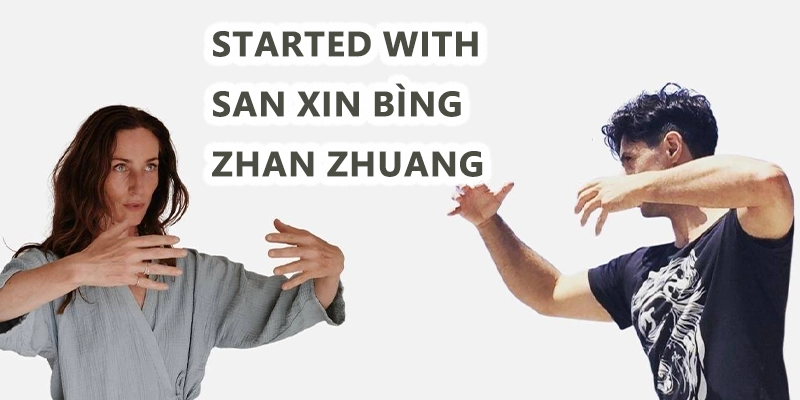
The “Three Hearts”: Bring gentle awareness to:
- Lower Dantian (Lower “Heart”): About three finger-widths below the navel, deep inside—the center of physical vitality.
- Middle Dantian (Middle “Heart”): Center of the chest—associated with emotions and respiration.
- Upper Dantian (Upper “Heart”): Between the eyebrows, slightly inside—associated with spirit and mind.
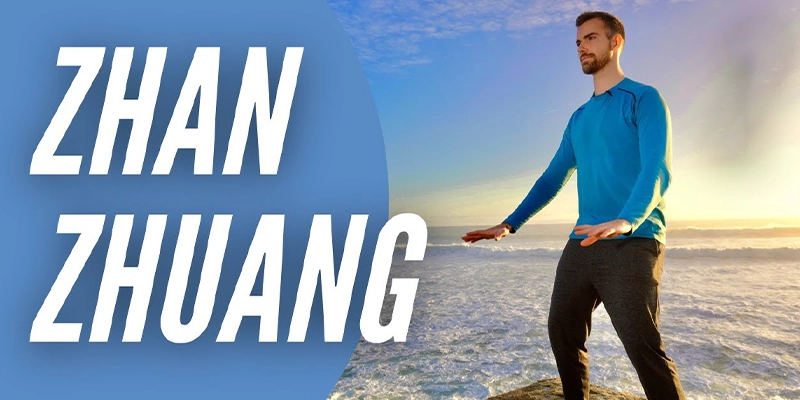
Intention: Gently sense these points aligning vertically. Imagine energy gathering and harmonizing in the lower dantian.
Relax and Breathe: Breathe naturally through your nose, deep into your abdomen. Scan your body continuously for tension and consciously release it. The posture should feel stable but not strained.
Start Small: Begin with just 3-5 minutes. Focus on relaxation and alignment rather than duration. Gradually increase time as comfort allows, potentially reaching 20-40 minutes.
Consistency: Regular practice, even short sessions daily, is far more beneficial than occasional long ones.
Power of Standing Still
San Xin Bìng Zhan Zhuang is more than just standing; it’s an ancient gateway to cultivating profound health, resilience, and inner peace. Its benefits of Zhan Zhuang range from reducing stress and improving balance to potentially aiding conditions like neuropathy and essential tremors.
By practicing this foundational Zhan Zhuang Qigong posture consistently, you get a timeless way of energy that strengthens not just the body, but the mind and spirit. As explored in works like Zhan Zhuang and the Search of Wu, it begins with a single, rooted stance.
FAQs
How to pronounce “Zhan Zhuang”?
- “Zhan”: Sounds like the English name “John,” but start with a softer “zh” like the ‘s’ in “measure” or “treasure,” and use a falling tone.
- “Zhuang”: Rhymes with “wrong,” but start with the same soft “zh” sound and use a high, level tone.
Say it smoothly: “jahn jwahng.”
How to do basic Zhan Zhuang (San Xin Bing)?
- Stand with feet shoulder-width apart, knees very slightly bent (don’t squat deeply).
- Keep your spine naturally straight and your head gently lifted as if suspended by a thread.
- Relax your shoulders, letting your arms hang loosely at your sides or rest gently on your lower abdomen.
- Breathe naturally and deeply into your belly.
- Focus on releasing tension throughout your body while maintaining the upright posture.
- Start by holding for just 3-5 minutes, focusing on relaxation and alignment over duration.
What is the Wudang Zhan Zhuang form?
The Wudang Zhan Zhuang form refers to standing meditation practices originating from or associated with the Wudang Mountain tradition of Taoist internal martial arts and Qigong.
While it has core principles in common with other Zhan Zhuang, Wudang styles often incorporate specific Taoist philosophies and may involve unique hand postures, subtle internal movements, or visualizations focused on balancing Yin/Yang and harmonizing with natural energy.
It’s a basic practice within Wudang systems for building internal strength (Nei Gong) and stillness.


